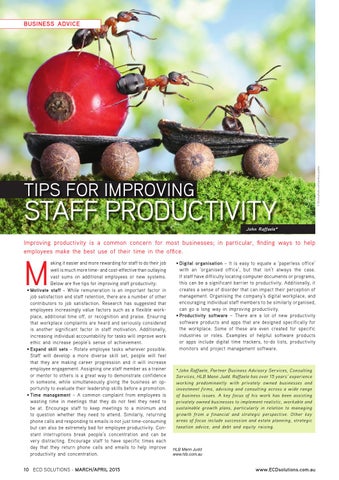TIPS FOR IMPROVING
STAFF PRODUCTIVITY John Raffaele*
Improving productivity is a common concern for most businesses; in particular, finding ways to help employees make the best use of their time in the office.
M
aking it easier and more rewarding for staff to do their job well is much more time- and cost-effective than outlaying vast sums on additional employees or new systems. Below are five tips for improving staff productivity: • Motivate staff – While remuneration is an important factor in job satisfaction and staff retention, there are a number of other contributors to job satisfaction. Research has suggested that employees increasingly value factors such as a flexible workplace, additional time off, or recognition and praise. Ensuring that workplace complaints are heard and seriously considered is another significant factor in staff motivation. Additionally, increasing individual accountability for tasks will improve work ethic and increase people’s sense of achievement. • Expand skill sets – Rotate employee tasks wherever possible. Staff will develop a more diverse skill set, people will feel that they are making career progression and it will increase employee engagement. Assigning one staff member as a trainer or mentor to others is a great way to demonstrate confidence in someone, while simultaneously giving the business an opportunity to evaluate their leadership skills before a promotion. • Time management – A common complaint from employees is wasting time in meetings that they do not feel they need to be at. Encourage staff to keep meetings to a minimum and to question whether they need to attend. Similarly, returning phone calls and responding to emails is not just time-consuming but can also be extremely bad for employee productivity. Constant interruptions break people’s concentration and can be very distracting. Encourage staff to have specific times each day that they return phone calls and emails to help improve productivity and concentration.
10 ECD SOLUTIONS - MARCH/APRIL 2015
• Digital organisation – It is easy to equate a ‘paperless office’ with an ‘organised office’, but that isn’t always the case. If staff have difficulty locating computer documents or programs, this can be a significant barrier to productivity. Additionally, it creates a sense of disorder that can impact their perception of management. Organising the company’s digital workplace, and encouraging individual staff members to be similarly organised, can go a long way in improving productivity. • Productivity software – There are a lot of new productivity software products and apps that are designed specifically for the workplace. Some of these are even created for specific industries or roles. Examples of helpful software products or apps include digital time trackers, to-do lists, productivity monitors and project management software.
*John Raffaele, Partner Business Advisory Services, Consulting Services, HLB Mann Judd. Raffaele has over 15 years’ experience working predominantly with privately owned businesses and investment firms, advising and consulting across a wide range of business issues. A key focus of his work has been assisting privately owned businesses to implement realistic, workable and sustainable growth plans, particularly in relation to managing growth from a financial and strategic perspective. Other key areas of focus include succession and estate planning, strategic taxation advice, and debt and equity raising.
HLB Mann Judd www.hlb.com.au
www.ECDsolutions.com.au
© iStockphoto.com/andrey pavlov
BUSINESS ADVICE
